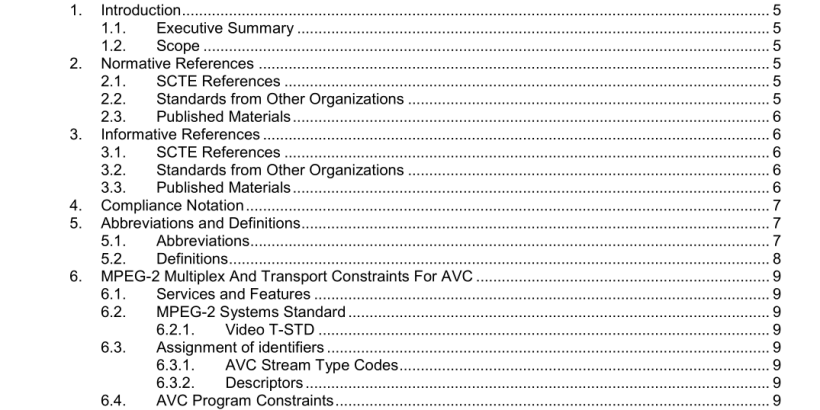ANSI SCTE 128-1-2018 pdf download.AVC Video Constraints for Cable Television
4. Compliance Notation
This word or the adjective“required’ means that the item is an absolute requirement of this document. This phrase means that the item is an absolute prohibition of this document. This word means the value specified shall never be used. This word or the adjective“recommended’ means that there may exist valid reasons in particular circumstances to ignore this item, but the full implications should be understood and the case carefully weighted before choosing a different course. This phrase means that there may exist valid reasons in particular circumstances when the listed behavior is acceptable or even useful, but the full implications should be understood and the case carefully weighed before implementing any behavior described with this label. This word or the adjective“optional’ means that this item is truly optional. One vendor may choose to include the item because a particular marketplace requires it or because it enhances the product, for example; another vendor may omit the same item. Use is permissible for legacy purposes only. Deprecated features may be removed from future versions of this document. Implementations should avoid use of deprecated features.
For bitstreams that carry the picture structure information (such as film mode), the pic_struct_present_flag shall be set to ‘1’ in the VUI. If the pic_struct_present_flag is set to ‘1’ in the VUI, then per AVC [2] a picture timing SEI is required to be associated with each access unit in the coded video sequence. If the coded video sequence does not require picture structure information, then the pic_struct_present_flag should be set to ‘0’ in the VUI. This flag in the VUI allows use of a picture timing SEI message with only the picture structure information without the need to include HRD information (such as CPB and DPB delay or initial values of the delay in the buffering period SEI). The Buffering Period SEI message is optional and may be ignored since this message duplicates the functionality defined in the MPEG-2 transport level. The Pan-Scan SEI message is optional but not recommended. See Section 8.2.3. All other SEI messages are optional. When supporting AFD, bar data, and closed captioning (see section 8.0 for more details), SEI user_data_registered_itu_t_t35 shall be used.
Tables 9A, 9B and 9C list the allowed compression formats and constraints for associated parameters (for non low delay mode applications). Table 9A covers Level 3.0 formats, Table 9B covers Level 4.0 formats, and Table 9C covers Level 4.2 formats. AVC Receivers that are capable of decoding Level 4.0 formats are also expected to be capable of decoding Level 3.0 formats. AVC Receivers that are capable of decoding Level 4.2 formats are also expected to be capable of decoding Level 4.0 and Level 3.0 formats. See Section 7.2.1.6 which specifies additional constraints for low delay mode applications. The value of “MaxFrameBuffers” is specified in Tables 9A, 9B and 9C below. For each of the resolutions in Tables 9A, 9B and 9C, the coded video sequence shall not require the units of frame buffers in the DPB (Decoded Picture Buffer) to be greater than MaxFrameBuffers to enable the output of the decoded pictures at the specified output times. The syntax element num_ref_frames in the AVC Sequence Parameter Set shall be set to a value less than or equal to the value MaxFrameBuffers. If the syntax element max_dec_frame_buffering is present in the VUI parameters syntax structure of the sequence parameter set, its value shall be set equal to MaxFrameBuffers. If the syntax element max_dec_frame_buffering is not present in the VUI parameters syntax structure of the sequence parameter set, the bitstream shall still obey the same constraints as if the syntax element max_dec_frame_buffering had been present and equal to MaxFrameBuffers.ANSI SCTE 128-1-2018 pdf download
